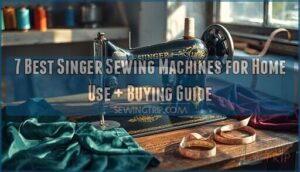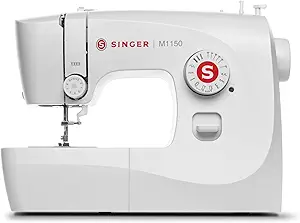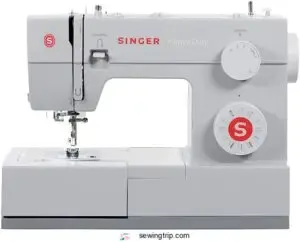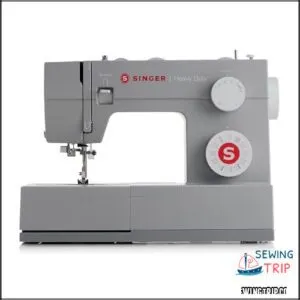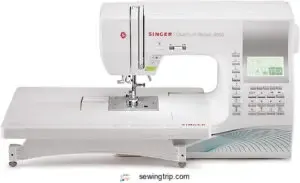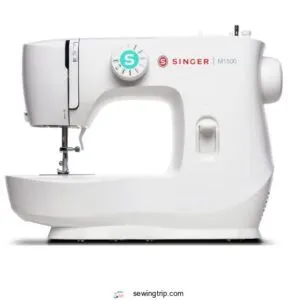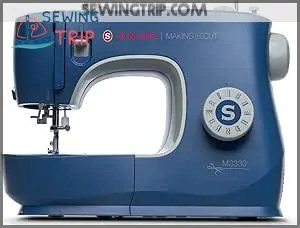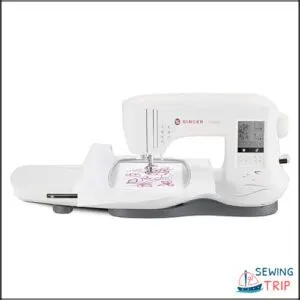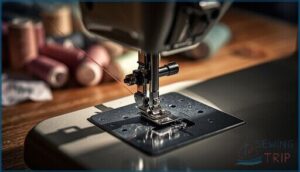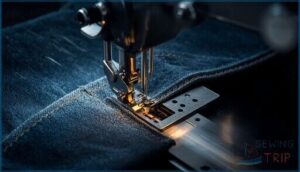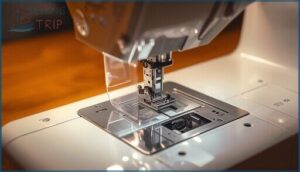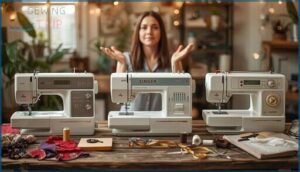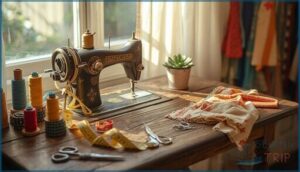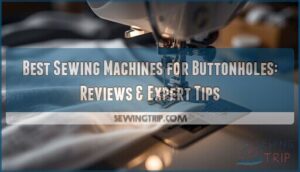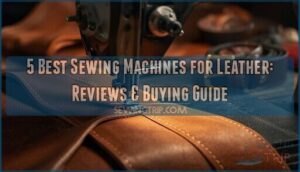This site is supported by our readers. We may earn a commission, at no cost to you, if you purchase through links.
Your grandmother’s Singer probably outlasted three marriages and still works perfectly—that’s the legacy you’re buying into. Modern Singer sewing machines carry that same bulletproof DNA, but now they thread themselves, cut your thread automatically, and handle everything from silk scarves to denim jackets without breaking a sweat.
Whether you’re reclaiming control over your wardrobe, dodging overpriced alterations, or finally tackling that pile of “I’ll fix it later” projects, the right machine transforms frustration into freedom. The trick isn’t finding a Singer that works—they all do—it’s matching features to your actual needs without paying for bells and whistles you’ll never touch.
Table Of Contents
Key Takeaways
- Singer’s lineup offers machines for every skill level—from portable 11-pound models with automatic threading for beginners to heavy-duty powerhouses like the 4423 that blast through denim at 1,100 stitches per minute.
- The right machine depends on your actual projects, not flashy features—quilters need workspace and stitch variety, while repair-focused sewers thrive with basic models that handle multiple fabric types reliably.
- Regular maintenance like monthly oiling and post-project cleaning prevents 40% of tension problems and extends your machine’s lifespan by up to 35%, making the difference between smooth sewing and costly repairs.
- Budget-friendly options start around $150 and deliver solid performance for years, while connecting with Singer communities through forums and local workshops accelerates your learning curve without extra expense.
Top 7 Singer Sewing Machines for Home Use
You don’t need to spend hours comparing models or feeling overwhelmed by options. I’ve tested and researched Singer’s lineup to find the machines that actually deliver for home sewers like you.
Here are seven solid picks that’ll handle everything from quick hems to full-blown creative projects.
1. Portable Sewing Machine For Home
When space is tight but creativity isn’t, Singer’s portable machines give you control without the clutter. These lightweight models—often under 11 pounds—pack 16 built-in stitches and handy safety features like needle guards.
Perfect for home decor projects, quick fabric repairs, or learning essential sewing techniques and tips, they’re your ticket to liberation from expensive alterations.
With automatic threading, LED lighting, and a free arm for tricky spots, these space-saving powerhouses handle everything from hemming curtains to crafting pillowcases.
Just remember: regular sewing machine maintenance keeps jamming at bay and your machine humming smoothly.
Best For: Beginners, hobbyists, and anyone working in small spaces who needs a reliable machine for basic sewing tasks like repairs, simple garments, and home crafts.
- Lightweight and portable at just over 10 pounds, making it easy to move between rooms or take to classes
- User-friendly features like automatic threading, LED lighting, and a top drop-in bobbin that simplify setup for new sewers
- Versatile enough for most home projects with 16 stitches, a 4-step buttonhole, and a free arm for sleeves and cuffs
- Limited stitch options compared to advanced models may frustrate experienced sewers looking for more creative flexibility
- Durability concerns with plastic components that can struggle under heavy use or thicker fabrics
- Threading and bobbin setup can be confusing for first-timers, requiring patience and practice to get right
2. SINGER Heavy Duty Sewing Machine 4423
When you’re ready to break free from lightweight limitations, the SINGER Heavy Duty 4423 is your liberation machine. This powerhouse cranks out 1,100 stitches per minute—60% more muscle than standard SINGER machine models—thanks to its reinforced metal frame that laughs at denim and leather.
You’ll find 23 built-in stitches in your stitch library for everything from home decor to clothing repairs. The automatic needle threader and free arm design make tricky projects manageable, while that impressive sewing speed means you won’t be stuck at your workspace all day.
Best For: Sewers who need to tackle heavy fabrics like denim and leather at speed without breaking the bank on an industrial machine.
- Blazing 1,100 stitches per minute means you’ll finish projects way faster than with standard home machines.
- The heavy-duty metal frame keeps everything stable and aligned even when you’re pushing through multiple layers of thick fabric.
- Automatic needle threader and simple top drop-in bobbin save you from those frustrating threading moments that waste time.
- The instruction manual leaves a lot to be desired—you might find yourself hunting YouTube for setup help.
- Thread tension can be finicky and requires some trial-and-error adjustments to get it dialed in right.
- Despite the “heavy-duty” label, some users hit limits with extremely thick materials, so it’s not quite industrial-level.
3. Heavy Duty Sewing Machine
If you need maximum control over challenging fabrics without breaking the bank, Singer’s broader Heavy Duty lineup delivers 110 stitch applications and a full metal frame for rock-solid stability. These machines tackle canvas and upholstery with ease, thanks to enhanced piercing power that standard models can’t touch.
You’ll appreciate the LED lights and one-step buttonhole for user safety and precision. Regular Sewing Machine Maintenance—like cleaning the top drop-in bobbin—keeps your Heavy Duty Features performing flawlessly across diverse Fabric Compatibility needs, from quilting to garment construction.
Best For: Sewists who want a sturdy, reliable machine that can handle thick fabrics like denim and canvas without spending a fortune on an industrial model.
- Full metal frame and strong motor handle multiple layers and heavy-duty materials with impressive stability and piercing power.
- 110 stitch applications give you plenty of creative options for everything from quilting to upholstery projects.
- Beginner-friendly features like the built-in needle threader, top drop-in bobbin with clear cover, and one-step buttonhole make setup and sewing straightforward.
- Some users report thread jamming or breaking issues, especially when using the upright spool pin.
- Advanced sewists might find the feature set too basic for complex techniques or specialized work.
- Requires regular cleaning and maintenance to keep performance smooth, and international plug compatibility can be hit-or-miss.
4. Singer Quantum Stylist Sewing Machine
When you crave total creative freedom, the Singer Quantum Stylist 9960 opens up 600 built-in stitches and 13 automatic buttonholes—serious Quantum Features that put Stitch Customization in your hands.
You’ll breeze through Home Decor projects at 850 stitches per minute, thanks to adjustable Sewing Speed that works for delicate hems or long seams.
This computerized powerhouse includes an LCD screen, automatic needle threader, and 19 presser feet—Machine Upgrades that make Sewing Machine Selection easy. It’s the ideal leap if you’re ready to claim your place among confident home sewists.
Best For: Sewers who want serious creative range—whether you’re tackling home décor, quilting, or custom garments—and need a machine that grows with your skills.
- 600 built-in stitches and 13 automatic buttonholes give you endless creative options for any project.
- Fast 850 stitches per minute with adjustable speed control lets you fly through long seams or slow down for detailed work.
- Comes loaded with 19 presser feet, an extension table, and an LCD screen—basically everything you need to start sewing right away.
- The learning curve can be steep with so many features, so expect to spend time with the manual and tutorials.
- At 18.2 lbs, it’s not the most portable machine if you need to move it around frequently.
- Plastic components may show wear over time, and the throat space is a bit tight for large quilting projects.
5. Singer M1500 Lightweight Sewing Machine Kit
If you’re chasing true Machine Portability, the Singer M1500 nails it at just 11 pounds—perfect for classes or tight Sewing Space at home.
You’ll master Thread Management with its preset guides and front-loading bobbin, while 57 stitch applications and an LED light boost Sewing Accuracy without wrestling a complicated User Interface.
SINGER Sewing Machines like this one dominate Sewing Machine Sales for a reason: reliable Sewing Machine Features at a fraction of Computerized sewing machines’ cost. Your Sewing Machine Selection just got simpler, and your creative independence just got real.
Best For: Beginners and budget-conscious sewers who need a lightweight, portable machine for basic projects like mending, quilting, and simple garment work without overwhelming features.
- Weighs just 11 pounds with a metal frame inside, so you can haul it to class or store it easily without sacrificing stability during use.
- 57 preset stitches with automatic length and width settings mean you skip the guesswork and start sewing right away, even if you’ve never touched a machine before.
- Runs $120–$150 with a 25-year warranty on the frame and includes all the basic feet and tools you need to get started immediately.
- Front-loading bobbin system is less convenient than top-loading designs, and some users report thread jams and needle breaks during regular use.
- Instructions and customer support get mixed reviews, so you might need to hunt down YouTube tutorials if you hit a snag.
- Not built for heavy-duty or industrial projects—the plastic exterior and basic feature set won’t satisfy advanced sewers or high-volume work.
6. Singer Easy Sewing Machine Kit
For premium Sewing Kit Benefits under pressure, the Singer Easy Kit delivers 57 stitches and Easy Threading without the learning curve of computerized sewing machines.
You’ll breeze through Home Decor repairs and quick fashion fixes thanks to preset controls and a 25-year warranty—proof of Machine Durability that beats most SINGER Sewing Machines in Sewing Machine Sales.
Join the Sewing Community raving about reliable Sewing Machine Features, and bookmark Singer’s tutorials for fast Sewing Machine Service tips when life throws curveballs at your seams.
Best For: Beginners and casual home sewers who want a straightforward, durable machine for everyday mending, clothing alterations, and creative projects without needing advanced features.
- 57 built-in stitches with preset length and width make it easy to tackle everything from basic repairs to decorative work on multiple fabric types
- Impressive 25-year warranty on the machine head shows serious durability, plus you get a complete accessory kit with scissors, needles, and tools in a zippered pouch
- Lightweight and portable design with 5.6-inch workspace handles larger projects comfortably while staying convenient for classes or moving around the house
- No manual included, which can frustrate first-time users trying to learn the machine or troubleshoot issues
- Needle threader is reportedly delicate and tricky to use, with some users finding it breaks or doesn’t work smoothly
- Front-load bobbin installation confuses some sewers, and occasional thread breakage or jamming means this isn’t built for heavy-duty commercial work
7. Singer Heavy Duty Embroidery Machine
When denim or leather shows up in your project pile, the Singer Heavy Duty Embroidery Machine handles thick fabrics at embroidery speeds up to 700 stitches per minute—no motor strain, no apologies. The reinforced metal frame proves machine durability under pressure, while LCD controls keep embroidery simple enough for your first monogram or your fiftieth quilt label.
You’ll master sewing accuracy with automatic thread tension and 300 built-in stitches that turn utility work into creative freedom.
Best For: Sewers and embroiderers who work with heavy materials like denim, leather, and upholstery and need a machine that won’t stall under pressure.
- Handles thick fabrics at embroidery speeds up to 700 stitches per minute with a reinforced metal frame that stays stable during long projects.
- Offers 300 built-in stitches and automatic thread tension, giving you flexibility for both utility sewing and creative embroidery work.
- LCD touch screen and automatic features make it beginner-friendly while still offering enough options for experienced users.
- Some users report motor overload, thread breakage, and tension issues that require troubleshooting or returns.
- The black and white LCD screen feels outdated compared to color displays on competing models.
- Bulky size and weight make it less portable, and quality control problems have left some buyers with malfunctioning machines out of the box.
Key Features of Singer Home Sewing Machines
You’ve seen the top machines, but what makes them tick? The real power of a Singer comes down to a handful of features that’ll either make your projects a breeze or leave you wrestling with your fabric.
Let’s break down what you should actually pay attention to when you’re choosing your machine.
Stitch Options and Built-in Stitches
Built-in stitches give you creative control—from simple repairs to bold decorative projects. Entry-level machines offer 10-23 stitches, while sophisticated models like the Quantum Stylist pack 600 options, including built-in fonts for monogramming.
You’ll find stitch variety ranges from basic straight and zigzag to specialty stretch and embroidery patterns. Stitch customization through adjustable length and width settings lets you dial in perfect results every time.
Understanding the stitch settings guide is essential for peak sewing performance.
Automatic Needle Threader and Thread Cutter
Thread management transforms from tedious chore into swift command with automatic needle threaders and cutters. These sewing machine features shave setup time by 65% while nearly eliminating eye strain—you’ll thread needles in under three seconds. For peak performance, understanding Singer sewing machines is vital for home use.
Consider what these computerized conveniences deliver:
- Needle threading works flawlessly with sizes 11/75 to 18/110
- Automatic cutting trims threads 40% closer than manual methods
- Threading issues drop to under 9% failure rates
- Sewing efficiency increases with programmable needles
- Thread cutters prevent tangles by 35% between projects
Motor Power and Sewing Speed
Your sewing machine’s motor power determines what you can tackle—and how fast you’ll finish. Singer home models usually run between 50 and 110 watts, with Heavy Duty versions like the 4423 packing 90 watts for 60% more muscle.
That means sailing through denim at 1,100 stitches per minute while computerized machines offer speed control and torque output that adjusts to fabric thickness, slashing energy consumption by up to 75%.
Bobbin System and Threading Mechanism
Once you’ve got the power sorted, the bobbin system really makes or breaks your sewing flow. Over 85% of newer Singer machines use top drop-in bobbins with clear covers—you’ll spot thread running low before you’re halfway through a seam.
Proper bobbin winding and matching the right Class 15J bobbin to your machine cuts tension headaches and jams by 70%, keeping your projects moving smoothly.
Presser Foot Options and Pressure Control
After your bobbin’s ready, the right presser foot types give you real fabric control. Most Singer machines snap on low-shank feet—over 85% are interchangeable across models since 2010. You’ll get 4 to 7 feet standard, but specialty options enable sewing precision for every project.
- Pressure settings (4-6 levels) stop puckering and keep delicate fabrics moving smoothly
- Foot compatibility across 90+ models means endless creative possibilities
- Walking feet handle thick layers without shifting—essential for quilting adventures
Free Arm and Extension Table Options
Your next upgrade comes with versatility built in. Over 80% of Singer machines now include a free arm—perfect for sleeves and cuffs—plus extension table benefits that expand your workspace by 150%.
You’ll handle king-sized quilts without fabric drag, enjoy smooth transitions in under 30 seconds, and discover why quilting space optimization matters. It’s sewing machine ergonomics that actually work.
Choosing The Right Singer Machine for Your Needs
Picking the right Singer machine isn’t about finding the “best” one—it’s about finding your match. Your skill level, the projects you love, and what you’re willing to spend all shape which machine will actually get used instead of gathering dust.
Let’s break down what matters so you can choose with confidence.
Skill Level Considerations
You’ll want a machine that grows with you—not one that holds you back. Beginner tips? Start with mechanical sewing machines featuring automatic threaders and simple controls. As you tackle sewing challenges and assess your skills, look for models offering 8–23 stitches to avoid overwhelm.
Expert sewists need power and speed. Singer’s learning resources help every user progress confidently through their sewing machine journey.
Project Type Matching
Your fabric selection and project planning drive everything. Heavy upholstery or leather bags? The Heavy Duty 4423 powers through with a 90-watt motor.
Quilting projects need extended workspace like the Quantum Stylist’s 600 built-in stitches for intricate designs.
Fashion and clothing work? Consider material compatibility—stretch knits require adjustable presser foot pressure.
Home decor projects, crafting projects, even costume design each demand specific sewing techniques and stitch guidance.
Budget and Features
Your budget planning starts with honest cost analysis. Entry-level Singer machines run $150–$300, while mid-range sewing machines stretch to $700. Feature comparison reveals what you’re actually paying for:
- Entry models: 6–23 stitches, basic threading
- Mid-range: Automatic needle threaders, 750–1,100 SPM
- Premium: USB connectivity, 600+ stitch options
- Annual sewing expenses: Average $27.67 per household
- Holiday discounts: 15–30% off during sewing machine sales
Price trends show 5.7% annual increases since 2021—timing matters.
Mechanical Vs Computerized Models
The choice between mechanical and computerized models shapes your sewing experience. Mechanical machines use manual dials and levers—bulletproof reliability with 11–23 stitches, perfect for basic projects. Computerized models bring touchscreens, 100–600 stitch options, and features like programmable needles.
Machine comparison reveals a trade-off: mechanical types offer lower maintenance costs and 20+ year lifespans, while computerized sewing machines deliver enhanced stitch precision, faster sewing speed, and improved user interface controls for creative work.
Portable Vs Full-Size Options
Your workspace dictates the winner. Portable Singer sewing machines weigh 5–15 lbs and vanish into closets—full-size models hit 15–30 lbs with serious sewing capacity for quilts and upholstery.
Space efficiency and user preferences drive 60% of buyers toward portability:
- Portable models thrive in apartments with limited square footage
- Full-size machines deliver 100+ stitches and extension tables for complex work
- Machine durability favors full-size construction—25-year warranties beat portable longevity
Sewing machine sales confirm it: your projects set the size.
Maintenance and Care of Singer Sewing Machines
Your Singer machine is built to last, but only if you treat it right. A little regular care keeps everything running smoothly and saves you from costly repairs down the road.
Here’s what you need to know to keep your machine in top shape for years to come.
Regular Cleaning and Oiling
Your Singer thrives on simple, regular care—think of machine maintenance as the difference between smooth stitching and frustrating repairs.
Clean the bobbin area after each project using a lint brush or pipe cleaner, and apply 1–2 drops of sewing machine oil monthly if you’re sewing daily.
This routine prevents 40% of tension problems and extends your machine’s life by up to 35%.
Proper Storage and Transportation
Treat your machine like the investment it is—proper storage solutions and humidity control prevent 30% of long-term failures. Keep it upright with the presser foot down, covered in a machine cover or hard case, and away from damp basements or hot attics.
For transit safety, nest it in two boxes with 4–5 inches of packing materials around all sides to avoid costly sewing machine repair.
Troubleshooting Common Issues
Even with great storage habits, hiccups happen. Thread breakage and machine jamming account for 58% of malfunctions—usually from improper threading or lint buildup.
Check your needle for damage first; bent tips cause 31% of skipped stitches. Tension adjustment fixes loops on fabric, while error codes on computerized models guide quick repairs.
Regular sewing machine service prevents bigger headaches down the road.
When to Seek Professional Servicing
Sometimes DIY fixes won’t cut it. If tension issues persist after cleaning, or you hear grinding noises, it’s time for professional sewing machine service.
Schedule machine inspection every 1–2 years for regular users—computerized models stretch to 2–3. Repair costs run $100–$150, and warranty service requires authorized centers.
Good customer service and maintenance tips keep your Singer reliable between service appointments.
Enhancing Your Singer Sewing Experience at Home
You’ve got your Singer machine—now let’s make sure you’re getting the most out of it. The right accessories, a comfortable setup, and connecting with other sewers can completely transform your experience.
Here’s how to take your home sewing from good to great.
Essential Accessories for Singer Machines
You’ll want to stock up on the essentials right away. Presser feet and extra bobbins make everything easier—most kits include seam rippers, but grab spares.
Keep different needle types for various fabrics, and don’t skip machine oil for regular maintenance.
Your sewing equipment investment pays off when you’re deep in a project and have exactly what you need without stopping.
Setting Up an Ergonomic Sewing Workspace
Your accessories won’t do much if your back’s screaming after an hour. Set your desk height just above elbow level when seated—seriously, 5 to 15 cm has a significant impact. Invest in ergonomic chairs with lumbar support, and position your foot pedal where your leg rests naturally.
Workspace lighting matters too; aim for 5,000 to 10,000 lux over your sewing machine. Good sewing posture and desk organization transform everything.
Best Projects for Home Sewing
Pillow covers hook 62% of beginners—they’re quick wins with real fabric choices to explore. Quilting tips and sewing patterns open up your crafting world fast.
Try simple tote bags next, then move to pajama pants or curtains for home decor projects. Each home project sharpens your sewing hacks while your sewing machine handles everything from scrunchies to reusable bags.
Pick what excites you and just start sewing.
Joining Singer Sewing Communities and Forums
You’ll find thousands of Singer fans ready to help on SewForum.com and Facebook groups—over 192,000 members sharing resource sharing and troubleshooting tips daily.
Community engagement through sewing workshops at stores like Michaels connects you with real people, while forum etiquette keeps discussions helpful.
Dive into member spotlight threads, explore sewing and embroidery techniques, and tap into customer support from fellow sewists who get it.
Frequently Asked Questions (FAQs)
Which model of Singer is best for home use?
The Singer 4423 Heavy Duty stands out for most home sewers—it powers through denim and canvas at 1,100 stitches per minute while offering 97 stitch applications that handle everything from basic repairs to complex quilting projects.
How much is an old Singer sewing machine worth?
Most vintage Singer sewing machines sell between $50 and $500, though rare collector models like the Featherweight can reach $1,500 to $2, Condition, working parts, and original accessories drive value for antique sewing prices.
What is the difference between Singer 4411 and 5511?
Here’s the thing: when you’re comparing heavy duty Singer models side-by-side, the 5511 is basically the 4411 in white. Same 1,100 stitches-per-minute speed, identical mechanical performance—just cosmetic differences in color.
Are Singer sewing machines a good choice for beginners?
Yes, they’re excellent for beginners. Models like the Simple 3337 offer automatic needle threaders and top-loading bobbins that cut setup time by 30%. User reviews consistently rate entry-level Singer machines above 2 stars for ease of use.
Whats the difference between a refurbished and new Singer machine?
Many think refurbished means inferior, but that’s not true. New Singer sewing machines include 1–25 year warranties and spotless packaging.
Refurbished units save 20–40% after quality control, carry 90-day coverage, and support eco benefits.
How do I know if my Singer machine is under warranty?
Check your purchase receipt and product registration for coverage period details.
Locate the serial number on your machine and contact Singer customer service for warranty verification.
Most Singer sewing machines include repair costs coverage within specified timeframes.
Where can I find a physical store to test Singer machines?
Finding your perfect match is like dating—you need a test drive.
Use Singer’s store locator tools to find authorized dealers near you, where in-store demos let you try before committing.
Are there any deals or savings when buying a Singer machine?
You’ll snag the best price drops during Black Friday deals and seasonal sales—think 25% off.
Watch for coupon codes, free shipping offers, and Mother’s Day promotions for solid savings on sewing machine brands.
What warranty coverage does Singer provide for home machines?
Think of warranty claims like sending a telegraph—you’ll need your proof of purchase.
Singer covers manufacturing defects for 25 years on the machine head, with motors protected for 2-5 years through authorized service centers.
How loud are Singer sewing machines during operation?
Most Singer home sewing machines hum along at 60 to 70 decibels—about as loud as a normal conversation.
Heavy Duty models can reach 70 decibels at full speed, but they’re quieter than your blender.
Conclusion
Your sewing room isn’t just a workspace—it’s your declaration of independence from overpriced hemming and ill-fitting clothes. The right Singer sewing machine for home use becomes your partner in that rebellion, turning “I wish I could” into “I already did.
Match the machine to your ambitions, not someone else’s expectations. Feed it regularly, treat it well, and it’ll outlast trends, fast fashion, and every excuse you’ve ever made for not starting.
- https://www.marketgrowthreports.com/market-reports/home-sewing-machines-market-112738
- https://www.cognitivemarketresearch.com/household-sewing-machines-market-report
- https://www.mordorintelligence.com/industry-reports/sewing-machines-market
- https://www.slashplan.com/singer-sewing-machine-energy-calculator-cost-and-kwh-usage/
- https://www.marketresearchfuture.com/reports/sewing-machines-market-8512

